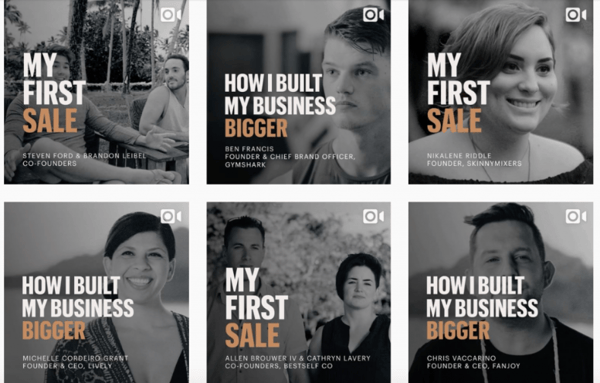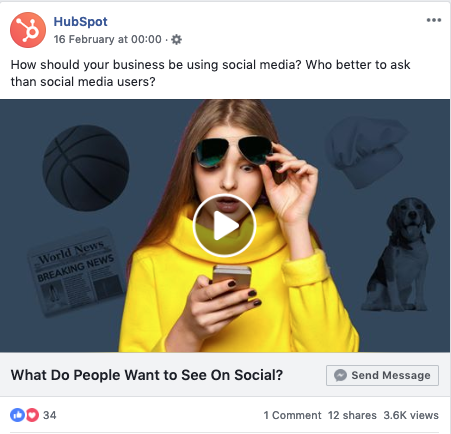According to the 2018 Global Digital Report, the current number of social media users is at 3.196 billion — and scales up to 13 percent year-on-year. If you are looking for the next step in your marketing strategy, and if you haven’t done so already, amplifying your social media presence may just be it.
Insight: In spite of the success of B2C companies in their social media strategy, many B2B companies continue to ignore the use of social media altogether or struggle to grasp using it.
Data: 75% of B2B buyers use social media to support their purchase decision (HubSpot). Out of all the social media platforms, 89% of B2B marketers use LinkedIn, 88% use Facebook, and 83% use Twitter (SproutSocial).
Key Action Point: In a time when consumers and most businesses are online and active on social media platforms, it is important to integrate social media into your strategy to amplify your brand and grow more leads.
B2B marketing has rapidly evolved over the years. Today’s B2B buyers are now mostly comprised of millennials — a group notorious for being always connected, online, and active on social media. Even the buying process predominantly happens online now.
With such a massive audience to cater to and with so many social media marketing channels to choose from, B2B brands and players need to have the right game plan or risk wasting valuable time and resources.
To help you get started, we’ve compiled some of the best practices we’ve seen over the years plus actual examples of B2B brands that have created a powerful social media presence.
1. Define Your Purpose
To set the groundwork for a successful social media strategy, you need to have a clear understanding of your purpose. This means asking yourself these questions:
-
Why do you want to be on social media in the first place, and how does social media help you achieve your overall business strategy?
-
Who is your target audience?
-
Which social media platforms are they likely to be using?
-
What type of content will you be creating?
-
What are your goals and how will you measure success?
-
What are your competitors doing on social media?
Once you are clear on these points, it gets easier to decide on the right social media best practice that may work for your brand.
2. Establish a Clear, Consistent Tone and Message
The first step to creating a tone and a voice for your brand on social media is to know your audience. By understanding their needs and pain points, you can be clear on how to position your brand so you can develop the right tone and message that resonates with them.
Use the right voice based on your brand personality and keep your buyer personas in mind. Your tone should be the general vibe of your brand.
An example of a brand that showcases consistency in its tone is Mrs. Hinch. With 1.9 million followers, the brand’s Instagram feed stands out in its consistency in terms of theme, graphics, and photography elements.

Shopify is another B2B brand that demonstrates consistency in their social feeds with their #BuildaBiz campaign where they give away $500,000 in cash, prizes, and mentorship. They share stories of these successful entrepreneurs on their social feeds.

With so many voices and brands to choose from, having a clear and consistent tone helps you stand out from everyone else and makes it easier for your audience to notice and remember your message.
3. Curate Your Tribe. Speak Directly to Your Brand’s Personas
How do you distinguish yourself from everyone else? It’s all about knowing and using the right narrative with your audience. The best way to do this is to really know your brand and have a think about the right type of content that your audience can respond and relate to.
This works better than posting for your own benefit. Be predatory. Find the weakness that comes from your competitor’s strengths and use that to come up with killer posts and campaigns.
Intel on Facebook shows us a great example of how to curate your content so it attracts and speaks directly to your target audience.

Speaking to tech lovers and gamers, Intel was able to come up with the right narrative which brought on an amazing response. When you know who you’re speaking to, it makes it easier to choose and create the right copy or content that your audience can respond to and will find relevant.
4. Go Multichannel
Understanding and knowing your niche makes it easier for you to choose the right strategy and platform that will help you stand out in your area. Whether you’re thinking about using just one channel or using multiple channels, keep these statistics in mind:
-
Facebook (89%), LinkedIn (81%), and Twitter (75%) are the three most used social media channels by B2B marketers. (MarTechAdvisor)
-
33% of B2B businesses use Instagram.
-
45% of marketers have gained customers through LinkedIn. (Quicksprout)
-
LinkedIn is 277% more effective in generating leads than Facebook. (HubSpot, 2018)
5. Provide Value through Content
Nothing makes you stand out more than delivering great content to your audience. You don’t have to be limited to sharing useful links and tips. Posts about company culture, industry news, branded content, and even job postings will always bring about interest, engagement and traffic.
Aventura Mall, for example, creates custom-made videos for seasonal promotions. With so much competition in their area, Aventura made its content stand out with the use of bright colours and videos.

HubSpot is known for its amazing library of resources — and it is this that makes them stand out even more in social media. Sharing useful and relevant tips and industry news not only makes them a go-to for information, but they also spice it up with catchy images and videos that also get a ton of engagement.
 |
 |
6. Engage Your Audience: Share Stories
Telling stories through social media is one of the most effective ways to engage your audience. IBM does a great job at amplifying their social media presence by sharing stories of the people who use their technology to improve their day-to-day life.
On top of sharing industry and product updates, Intel hinges on social media engagement as well through win-a-new PC contests and campaigns. These are always popular, drive likes and shares and helps the brand interact with their audience.

7. Know the Best Time to Post
It is no secret that posting on specific times of the day lead to better engagement. And when you’re after high engagement and traffic, it is ideal to schedule your posts at certain times of the day to give it the most traction. Using timing analytics helps you boost more traffic, promote brand awareness, generate leads, and increase sales on different social media platforms.
Here’s a look at the best times to post on Facebook.

In LinkedIn, the most clicks and shares have been noted on Tuesdays, 11:00 AM to 12:00 PM. The best time to post is from 7:00 to 8:00 AM and 5:00 to 6:00 PM.
8. Use Paid Media
If you’re looking for maximum reach and looking to drive brand awareness and conversion for a shorter amount of time or for a select audience, setting aside a portion of your budget for paid media is the way to go.
But running Facebook Ads is different from running sponsored content on Instagram or Twitter. This is why it helps to understand the purpose of your campaign and know your audience so it is easier to decide on the right platform that gives you the best results.
Although Facebook boasts of the largest users, for the B2B market, it is ideal to set your social media strategy on LinkedIn to take advantage of its large professional and business network. As of 2018, 65% of B2B companies have acquired a customer through LinkedIn paid ads.
According to research, the top five paid advertising methods used by B2B marketers are SEM (66%), print or other offline promotion (57%), traditional online banner ads (55%), promoted posts (52%), and social ads (51%).
Visatvu Solutions is a business management software firm that caters to oilfield services. Their use of display ads and sponsored inmail drove results that led to capturing 19 out of 20 leads in just the first week.

 HubSpot’s short and direct Text Ads were far more effective on LinkedIn, leading to a 60% increase in their clickthrough rate. And this makes sense given LinkedIn’s audience base that is made up primarily of professionals out to network or B2B players.
HubSpot’s short and direct Text Ads were far more effective on LinkedIn, leading to a 60% increase in their clickthrough rate. And this makes sense given LinkedIn’s audience base that is made up primarily of professionals out to network or B2B players.
9. Automate Marketing Processes
Many B2B players doing well on social media rely on marketing automation software to save on time and resources. From scheduling social media posts to automating responses to comments and queries, these platforms help you maintain consistency.
Here are some of the most commonly used marketing automation platforms you can choose from today:
-
Agora Pulse - features a comprehensive set of social media automation tools, schedule content throughout six social networks, collaborate with your team, track and measure performance through smart analytics
-
HubSpot - offers a full platform for marketing, sales, customer service, and CRM that features its own marketing, sales, and service hubs. Great for increasing traffic, connecting, closing, and managing leads.
-
HootSuite - one of the most widely used, has an easy-to-use post scheduler, allows you to track your social media performance, features an advanced search that allows you to search for influencers, comes with an inbuilt advanced analytics
-
Coschedule - easy-to-use post scheduler and a requeue feature, allows you to schedule 60 posts all at once, has customer support and analytics features
-
Buffer - features an easy-to-use content scheduler, offers one of the most comprehensive analytics.
10. Measure and Analyse Data
No matter what social media strategy works best for your business, it is important to have the means to measure results for you to gauge what campaigns are working. This helps you save on costs and helps your team align on the KPIs that matter.
When you’re aiming to increase your reach, some metrics you should be tracking are your impressions, follower count, engagement, paid and organic reach.
If you are looking to drive more leads for your brand, you should be tracking your click-through rate, conversions, and social media leads.
Knowing the goals and these metrics helps you to decide on the best social media analytics platform to use.
Case Study on the Power of Social Media at Work: The Maersk Story
Maersk is the fastest-growing social media player in B2B — and you’ll be surprised to know that it’s a container shipping company. Yet Maersk boasts of a growing social media presence not only on Facebook (3.1 million followers) but on Instagram (135k followers), Twitter (75.6k followers), and LinkedIn (304k followers).

They began using social media as their primary means of communication, but over time they managed to get the most value from their social media channels to share their story and create their own narrative, which have helped them add value to their bottom line and get a return of investment that is approximately 1500% just for their Facebook page alone.
Since then, Maersk is already crafting the next step in their social media strategy by exploring how they can use it to amplify their sales, customer service, and even to transform their company’s internal culture.
Tying It Together
Is a social media strategy important for B2B brands, and do you need it? Many top B2B brands today prove that you do.
There is no contest. To succeed in your B2B marketing efforts and to be relevant today, you need a strong online presence. The results for these brands speak for themselves. When done right, social media can indeed be a powerful tool.
If you’re curious to find out more information on how you can unlock your brand’s full potential through social media, contact us today.









![#KatieTalks to Step Change’s Robert Steers [PODCAST]](https://blog.hellostepchange.com/hubfs/BLOG/Posts/5-Connection/katie-talks-robert-steers.001.jpeg)






